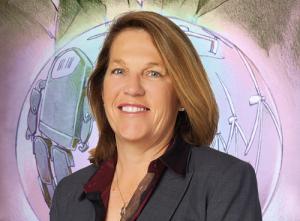Guidehouse
Karin Corfee is a partner in Guidehouse’s global Energy, Sustainability, and Infrastructure segment with key expertise in strategic planning, renewable energy, distributed generation, and energy efficiency. Over her 30-year career, she helped develop policies to facilitate increased deployment and optimization of energy efficiency and distributed energy resources. Strategic planning engagements include the California Energy Efficiency Strategic Plan, CAISO Five-Year Strategic Plan and the New Jersey Renewable Energy Plan. Karin recently focused on examining new business models, including financing initiatives, third-party ownership structures, and community solar.
What major changes have we seen over the last year to the key opportunities and threats utilities are facing? What can utilities do to be better prepared for these changes?

As we begin the recovery from a pandemic with a devasting impact on the health of our citizens, our public health system, and our economy, we are reminded that we are all connected. We are pulling together to help flatten the curve while also doing everything we can to support those in need and revitalize our economy.
But the world will never be the same as more of these gray rhino (or highly probable, high impact, yet neglected) events will occur going forward. This year, resiliency and adaptation have become even higher priorities for utilities to address.
Although slower moving, the climate crisis is still the world's largest existential threat. Without addressing the risks today, it could have a much more acute and sustained impact on our lives and economies.
Net zero is the new trend. More and more countries, states, cities, and corporations are pledging to achieve net zero carbon emissions by mid-century or before. As of late 2019, more than fifteen states had set targets calling for at least a seventy-five percent reduction in greenhouse gas emissions by mid-century.
Additionally, more states are enacting legislation, regulations, or executive orders that set aggressive renewable and greenhouse gas emissions reduction targets. In addition, ambitious targets at the local level are also on the rise. For example, Houston, Texas, the center of our oil industry, has pledged to be carbon neutral by 2050.
Utilities are embracing their key role in decarbonization. Today, over sixty-five percent of all customer accounts in the U.S. are served by a utility with a carbon or emission reduction goal. They are incorporating these goals in stronger commitments as part of their overall Environmental, Social, and Governance (ESG) responsibilities.
Assessing ESG performance will help utilities hedge their risks and tap into new business opportunities. Utilities will need to respond holistically around investments, strategic plans, business and regulatory models, products and services, and operations and people to capitalize on these opportunities.
Executing a clear and ambitious ESG strategy demonstrates adaptation, resilience, preparedness, and leadership, which will be rewarded by customers, employees, shareholders, and investors.
We must embrace change and adapt. In the words of investor and financial commentator Jim Rogers, "Those who cannot adjust to change will be swept aside by it. Those who recognize change and react accordingly will benefit."
PUF posed a baker's dozen questions about power's future to a similar number of the thought leaders at Guidehouse:
- Dan Hahn — You have a short elevator ride alone with the CEO of a major utility. What would you want to tell him or her?
- Karin Corfee — What major changes have we seen over the last year to the key opportunities and threats utilities are facing? What can utilities do to be better prepared for these changes?
- Erik Larson — Are utilities well-equipped for next generation Energy Cloud business models? What is your view on the industry's readiness? What can utilities do now to be ready?
- Dan Bradley — How will utilities' relationships with their customers change over the next decade? How can utilities get ahead of this?
- Ted Walker — We all hear of "as a service" offerings across many other industries. What does this mean for utilities? What does energy as a service look like?
- Shannon Graham — How are European energy companies positioning themselves in a quickly decarbonizing market? What lessons can be learned from them for U.S. utilities?
- Derek Jones — Approximately one-third of energy use in the U.S. is for transportation. How can utilities tap into this market in a significant way?
- David O'Brien — What are the major regulatory changes you see in the next decade? What is needed from regulators to optimize outcomes for all stakeholders?
- Margot Everett — What are the major changes to how utilities should approach rate design over the next decade to deal with challenging industry dynamics?
- Michelle Fay — What will the utility of the future look like in 2030? How will it be different from today's utility?
- Rick Rodman — How has risk management changed for utilities? What can utilities learn from other industries?
- Jenny Hampton — How can utilities use design thinking to develop game-changing innovations? What lessons can be learned from other industries?
- Danielle Vitoff — What role can utilities take in their customers' quest to decarbonize? How have we seen utilities shifting more decarbonization choices to their clients?


